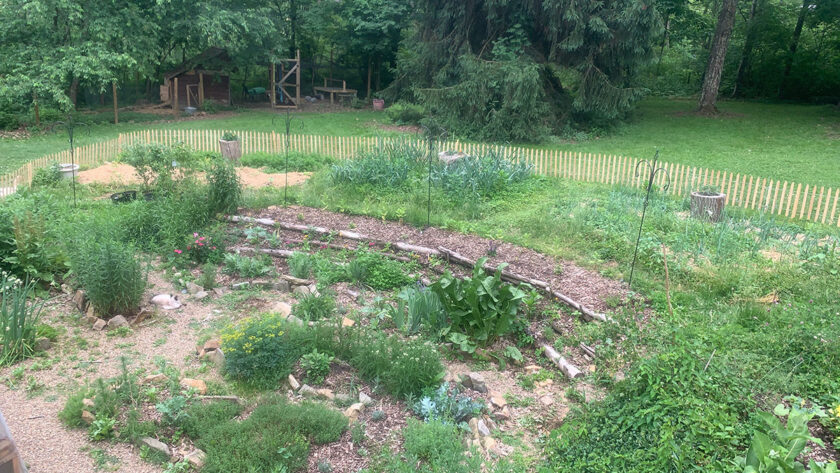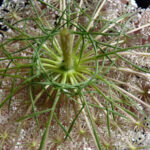A garden full of life, joy, wildness, and spirit–where the vegetables, herbs, fruits, and nuts grow fat with the joy of being nurtured, where the spirits are working with the gardener for the good of all, and where all is in right relationship–this is a beautiful garden both physically and metaphysically. This is a garden that brings peace, joy, and connection and that fosters the health of the broader soil web and ecosystem. In last week’s post, we explored the philosophy behind animistic gardening–how we can bridge between the domineering and domestication-driven philosophies of modern culture and modern gardening and instead find a way to approach a garden as an animist–in right relationship with the physical and metaphysical worlds. Today’s post explores the actual physical practices of animistic gardening–how the things we do to create and nurture our garden can align with animistic spiritual practices. This is a follow-up from my last post on animstic gardening, where we dug into the idea of animsitic gardening and its philosophies. Today’s post puts philosophies into practice by explaining some gardening practices that support and facilitate a deep relationship with the spirits of nature.
Previous posts in this series include an introduction to animism, co-creating intentions with nature, animism and permaculture introduction and ethics, connecting to the Genius Loci (spirit of place), and addressing waste. If you haven’t read the previous posts, I would strongly suggest starting there, as this post builds from the previous ones.
And before we get on to the main post, I do want to share a bit about my timing. I like posting about gardening in the late fall because this is when I do most of my garden bed prep for the coming season. Once the leaves drop, you can use them to sheet mulch your beds with a new layer of compost (finished or unfinished), sheet mulch weedy beds, add winter cover crops, plant your first crop of the next year–your garlic–and generally put your garden in shape to plant in the spring. So I actually spend more time in my garden in Sept-Dec than almost any other time of the year–hence why I talk a lot about gardening in the fall on the blog. So with that, let’s explore some practices of the animstic gardener!
Animistic Gardening
Animistic Gardening is the practice of tending a plot of land for the purpose not only of growing food but also in creating sacred relationships with the spirits of nature. I offered the following principles in last week’s post:
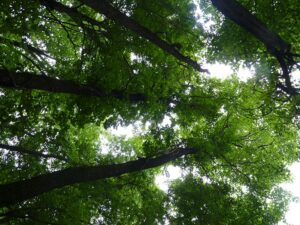
- Seeking right relationship and balancing domesticated and wild spaces: Animistic gardeners seek the right relationship with the spirit world and world of nature, which includes balancing heavily tended with wild spaces and working with nature rather than against nature.
- Employing garden techniques to support a healthy ecosystem. Animistic gardeners and using gardening techniques that help foster a healthy soil web and ecosystem, which includes techniques that involve minimal soil web disruption, growing healthy soil, using a mixture of perennials and annuals, and creating features of the garden that create habitat, pollen, nectar, and other food sources for life.
- Reciprocating relationships. Special attention is paid to engaging in reciprocal relationships with the spirit world, honoring the sovereignty and wishes of the spirits of nature on the metaphysical world. In the physical world, attention is paid to providing gratitude and offerings for the bounty of nature and making sure you give as much as you receive.
- Using organic and regenerative techniques. An animistic garden uses techniques that foster life and support the health of the ecosystem. This includes using no-till approaches, using integrated pest management and natural methods for addressing pests, working out develop healthy insect communities to address pest imbalances,
- Careful resource selection and use. Just as the animistic gardener seeks right relationship with the land where they garden, they also seek to engage in ethical resource use for any materials that are brought from outside, making sure these materials are either a) recycled/waste or b) harvested/obtained in an ethical manner that honors the spirits
Given these principles, let’s look at a variety of strategies that you can use to put these principles into action.
Principle 1: Zones of Cultivation
I find permaculture design‘s Zones of Use an extremely practical way of addressing the domestication to wild divide that needs to be addressed in animistic practice. The principle of the zone is simple: when you divide the available land you are tending into five zones and those zones have different functions I’m making a slight modification to the original practice in permaculture here to think less about use and more about level of cultivation.
- Zone 1 is your home and immediate surroundings, places you go to every day. These are places that are also super easy to access, where you will go as part of the natural course of your day, and you will always visit. Something like a kitchen garden, path to your animals, your porch, are all part of Zone 1.
- Zone 2 is still close, and likely visited frequently, but the difference here is that you have to make an intention to visit it rather than just visit as part of your normal day. This might include your medicinal herb garden or larger vegetable garden, or a small greenhouse next to your home.
- Zone 3 is then even more lightly tended and occasionally visited–berry patches, a wood shed, a cultivated food forest, and so forth. Zone 3 may be physically further away or require more effort to get to in some way.
- Zone 4 is still further away and even less tended, perhaps a local edge of the forest where you go foraging for mushrooms once a week and occasionally plant some additional medicinal woodland herbs.
- Zone 5 is wild, untended, just the land growing as the land sees fit without your intervention. There is no active cultivation in Zone 5.
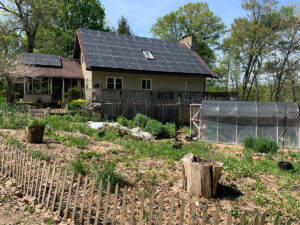
Here’s an example of how it works on the Druids Garden homestead: Our Zones 1 include our animal coops and runs, the paths to the coops and runs, the greenhouse, and main upper garden and herb garden. These are easy to access, we are there every day, and because of the animals, these spaces get visited very frequently, multiple points a day. The greenhouse is watered when we water the animals, and the entrance to it is only about 30 feet from the house. Our Zone 2 is the rest of our gardens–places that are quite nearby but we have to make a point to go into them. Zone 3 includes more gardens in other parts of our yard–a squash bed and my perennial garden that grows mostly Jerusalem artichoke, rhubarb, berries, and nettles–as well as my forest hugels planted with gooseberry and currants. I visit these spaces maybe once a week and tend them lightly, weeding or harvesting from the hugels. Zone 4 is the first half of the forest that makes up half of our property. Sections of this forest I have worked to tend into a food forest with an understory of hazelnut and pawpaw, and an overstory (already existing) of sugar maple, hickory, oak, and cherry. We are blessed in that this land was already abundant when we bought it, but I’ve been working to plant even more abundance as well as preserve and protect woodland medicinal species. Finally, there is the back part of our forest–with a ton of bitternut hickory–and the spirits of the land have told us clearly that this is to remain wild. So it does. We do not tend to this space, we do not plant in it, and all we do is enjoy the path through it occasionally when walking the land. And maybe occasionally harvest some wild mushrooms or berries from the edges of the paths.
In this way, you can see that we move from heavily cultivated spaces: our gardens in Zones 1-2, which are most of our annuals and also perennial herbs/medicinal herbs to zone 3, which is mostly perennial crops that do not need much tending. Zone 4 is wild forest with some light cultivation, and Zone 5 has no cultivation.
Figuring out your Zone 1 to Zone 5 in your own space can help you find spaces for balancing areas that you are fully tending vs. areas that you are leaving wild to the spirits of nature. The way I like to think about it is this–zone 1 is the area where I will spend the most time and also have the most direct tending and cultivation, while Zone 5 is a space that I do not actively tend or cultivate–it is left to the spirits. We negotiated this particular setup with the spirits of the land using practices described in this post and this post.
If you are in a more urban setting, you can still establish zones of use. For example, a potted set of plants on your porch and front stoop can be a Zone 1 situation, where a back alley with flowers and seeds scattered can have minimal tending. The principles apply regardless of where you live, and can also be applied to indoor spaces.
The idea of zones helps you figure out how nature–and the wildness of her–can be part of your garden plan. If you have a larger space like I do, you can see how we designated lots of spaces for wildness, and the zones essentially represent the amount of cultivation and tending we offer. There are spaces that are wild and completely untended and there are spaces that are very heavily tended.
Principle 2: Stacking Functions
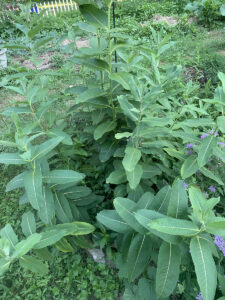
Stacking functions maximizing on the fact that one thing–such as a plant–can have multiple functions. When you choose plants that have functions both for you and that benefit nature, you are creating choices that have multiple benefits and rewards. When you work to stack functions, plants and other features can have multiple benefits to cultivate ecosystems and offer something to the human tender of the garden. For example, one of my favorite garden vegetables is milkweed–I can get four harvests from it throughout the season, and it is an incredibly important food, nectar, and habitat for a variety of insects. The dried stalks can also be made for cordage, and the milkweed seeds can be harvested and scattered to new areas using the principles of refugia to help spread this important plant.
Another plant I love is blue queen sage–she produces long blooms during the nectar dearth for bees and insects, inviting a host of beneficial insects and also providing me with some herbs for eating and sacred use. An in-ground garden fountain may provide beauty but also provide water for insects and birds and serve as a habitat for a local frog population.
You can plan a garden in this way–thinking about how you will invite nature in, create space for nature, and plant plants and create features that benefit life through stacking functions. Everybody wins!
Principle 3: Cultivating Ecosystems
Often, humans see their garden as something to defend from external nature rather than work with nature. Stemming from Principle 2, one of the things you can do is work not to create a garden but an ecosystem. A garden is not a collection of individual plants perhaps planted to benefit humans, but an ecosystem that can support many different kinds of life. Think about what life might want to be present in your garden–and plan for that life. At the Druid’s Garden homestead, we have goals not only of producing nourishment for ourselves and our flocks, but also goals of supporting wild birds, insects, and other life. Thus, consider the basic needs of other beings in that ecosystem–water features, plants that offer habitat and food, and so on.
Creating an ecosystem allows for that ecosystem to balance itself and address imbalances, such as in the pest population. By inviting in insects, such as predatory wasps, we get essentially free integrated pest management-the other insects keep the problematic ones in check, and thus, the ecosystem functions more effectively. This also means less intervention on our part to try to keep problematic insects in check.
Consider also how you effectively tend that ecosystem–when do you clear beds or do pruning? When is the least disruptive to create new beds? For us, we clear our annual beds at the end of the season but we do not clear our perennial beds–which contain most of the habitat for insects, etc, until the spring. This allows insects to find places to shelter during the winter and honors their needs.
As you are doing this, as an animist, cultivating an ecosystem helps you get in touch with the Genius Loci, the spirit of place. Talk with the Genius Loci, connect with them, and see what needs the broader ecosystem has that you can provide.
Principle 4: Balancing Perennial vs. Annual Plants
Another useful principle is to think about the balance of annual vs. perennial plants in your garden. Perennials create stability in a garden, you do not need to disrupt the soil web to remove them after the growing season is over, and they are planted once with many years of benefit. Most forests and stable ecosystems are perennials and self-seeding annual plants. It’s not that there isn’t a place for your peppers, tomatoes, and potatoes, but that these should be balanced by perennial crops–berries, nuts, perennial greens, and so forth. For example, we have large annual gardens that also have pollinator-friendly hedges, as well as fruit patches with perennial fruits, nuts, and berries. A beautiful nettle patch provides nutritious greens in the spring and fall, and we only had to plant it once, so it is stable in the ecosystem. The goal here is that you create an ecosystem that has plants that persist beyond one growing season, creating habitat, food, and shelter.
Perennial trees, nuts, berries, and greens also allow you to cultivate longer-standing relationships with the plants and also contribute to a more healthy soil web, see next principle.
Principle 5: Honoring and Cultivating the Soil Web of all Life

In many garden practices, tilling a garden is just the thing everyone does. But, tilling a garden is one of the most destructive things you can do long-term for soil health. Tilling kills the soil web of life (billions of individuals), promotes runoff, and depletes the soil, thus requiring the inputs of chemical fertilizers which create more environmental hazards. Modern methods of agriculture require yearly tilling and then because the soil is dead after repeated tilling, chemical fertilizers are dumped into the soil, creating massive amounts of runoff (and algal blooms the size of Texas in the Gulf of Mexico). Tilling is causing many conventional fields to slowly lose their fertility and lose topsoil at an alarming rate.
Two common methods of avoiding tilling is sheet mulching and using hugelkultur approaches. Sheet mulching, or lasagna gardening, allows you to create rich beds that honor and create a healthy soil web. A healthy soil web is the foundation of all other life in the ecosystem. Here are two posts for how to create effective sheet mulched garden beds. And here is where you can learn more about hugelkultur as a technique for gardening. Both of these techniques also use “waste as a resource” which can be very helpful as you are honoring all life and the value of life in your garden.
Other management of soil may include cover cropping between seasons, composting in place, and using animals in a rotational graze system (plant one season in one garden, give the other side of the garden to chickens for the season, and vice versa). There are many methods you can use to avoid tilling and promote soil health. As an animist–recognize the billions of lives and the song that is present in healthy soil. This can be directly worked with an honored.
You can also honor the soil web ritually, which we will explore in the next post in this series.
Principle 6: Evolution and change
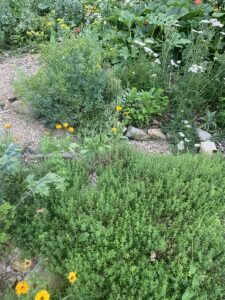 Especially when you are working with perennial agriculture, you want to think about the long term and how things change and evolve. Nature is adaptable, resilient, and beautiful in her ever-changing nature. We have to work to honor that change and think about how to work with those changes as they come. Nature teaches us to be flexible in her rhythms and that is a powerful lesson from spirit. What seeds will scatter into new areas? What new things pop up in the garden? How far does the milkweed patch want to travel? All of these delightful unexpected things are an important part of your experience with the spirits of nature.
Especially when you are working with perennial agriculture, you want to think about the long term and how things change and evolve. Nature is adaptable, resilient, and beautiful in her ever-changing nature. We have to work to honor that change and think about how to work with those changes as they come. Nature teaches us to be flexible in her rhythms and that is a powerful lesson from spirit. What seeds will scatter into new areas? What new things pop up in the garden? How far does the milkweed patch want to travel? All of these delightful unexpected things are an important part of your experience with the spirits of nature.
For example, there has been much evolution and change in our perennial meditation garden, which is all perennial herbs and flowers for pollinators. While they were neat and tidy when I first put them in, they have grown wild and large. Some plants thrived and expanded and others did not do well and died off. A lot of what I find myself doing these days is harvesting extra plants to give to others, harvesting to make medicines and spiritual tools, and simply tending the space. My paths are full of medicine, and to maintain those paths, I honor those plants by harvesting them. For example, a friend of mine and her daughter came over not so long ago and wanted to make some tinctures for the first time–I had a batch of echinacea that had seeded into the paths, and I told her we could honor these plants by harvesting them. We made offerings, sought permission, then harvested them for their medicinal roots to make the tincture. This practice allowed us to flow with the changes in the garden, tend, and honor the space.
We have to remember that nature is not under our full control, and even in a managed space like a garden, unexpected things happen. Flow with the unexpected and find joy in the evolution. Listen to the voices of the plants, the garden, and the soil and see what happens next.
Conclusion
In this post, we really attended to the “outer” work of tending a garden from an animistic perspective. A lot of what I’ve shared above is really about working with nature and honoring nature as an equal partner in the goals of your garden. In our final post in this series in a few weeks (because we have Samhain coming up before then!), I’ll share ritualistic, spiritual, and metaphysical ways of engaging with the garden as an animistic gardener. Blessings to you this week and on your journey! May it ever be fruitful, joyful, and unexpected!
